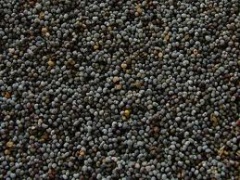Poppy seed
| Infobox on Poppy seed | |
|---|---|
| Example of Poppy seed |  |
| Facts | |
| Origin | - |
| Stowage factor (in m3/t) | - |
| Humidity / moisture | Approx. 8% |
| Oil content | 45 - 50% |
| Ventilation | See text |
| Risk factors | See text |
Poppy seed
Description / Application
Poppy seed is an oilseed obtained from the opium poppy (Papaver somniferum). The tiny kidney-shaped seeds have been harvested from dried seed pods by various civilizations for thousands of years. The seeds are used, whole or ground, as an ingredient in many foods, and they are pressed to yield poppyseed oil.
The poppy seed harvest can be a by-product of opium poppy cultivation for opium, poppy straw, or both opium and poppy straw. Conversely, poppy straw can be a by-product of cultivation of poppy seeds.
Poppy seeds have primarily culinary uses, as intact seeds and as a paste of ground seeds. The seeds are used as a spice, a condiment, a decorative garnish, a thickener, and a main ingredient. They are used in many baked goods, main course dishes, and desserts.
They are also the source of poppyseed oil, and the solids that remain after the oil is expressed are a valuable animal feed. Poppy seeds are often a component of bird seed mixtures for both wild and domestic birds as they are very nutritious and can also be given separately in higher amounts to treat gastrointestinal distress, diarrhoea, and similar afflictions as well as pain and discomfort in many types of birds.
Compared to the seed pod and straw, the seeds contain very low levels of opiates. The seeds may be washed to obtain poppy tea. But A large amount is needed, around 300-400g depending on the levels of opiates.
Since poppy seeds are relatively expensive, they are sometimes mixed with the seeds of Amaranthus paniculatus, which closely resemble poppy seeds.
Shipment / Storage
Poppy seed is transported as break-Bulk Cargo in bags of woven natural materials (e.g. jute) or woven plastic bags. The very small poppy seeds easily penetrate the fabric of the bags and, since there is a risk of bleeding, they are packaged in double-layer bags or in bags of particularly tightly woven fabric.
Recommended ventilation condition is an air exchange rate of at least 10 changes/hour (airing).
Risk factors
- Self-heating / Spontaneous combustion
- Odor
- Contamination
- Mechanical influences
- Toxicity / Hazards to health
- Shrinkage/Shortage
- Insect infestation / Diseases
Note:
Because of its tendency to self-heating/spontaneous combustion, poppy seed may behave like substances from Class 4.2 of the IMDG Code.











